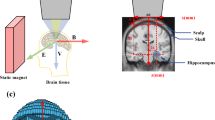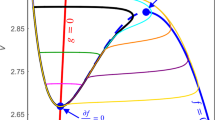Abstract
Target wave and spiral wave can regulate the collective behaviors of electrical activities in neuronal systems as a powerful ‘pacemaker’. Disordered states occur when normal signal propagation among neurons is disturbed and neuronal disease could be induced. In this paper, a stable rotating spiral wave is developed as initial state that the two-dimensional neuronal network of Hindmarsh–Rose neuron shows distinct periodicity and regularity in space, and then, some parameters are changed sharply to model the destruction effect induced by external large forcing or internal collapse, and the destructed areas will be expanded to occupy a larger area by expanding the damaged boundary in random way. The collapse and instability of spiral wave, ordered states could be predicated by monitoring and analyzing the time series of some nodes. It could be useful to detect the emergence of disaster in some biological or ecological systems.


















Similar content being viewed by others
References
Kalyuzhny, M., Kadmon, R., Shnerb, N.M.: A neutral theory with environmental stochasticity explains static and dynamic properties of ecological communities. Ecol. Lett. 18, 572–580 (2015)
Layeghifard, M., Makarenkov, V., Peres-Neto, P.R.: Spatial and species compositional networks for inferring connectivity patterns in ecological communities. Glob. Ecol. Biologeogr. 24, 718–727 (2015)
Jeppesen, E., Brucet, S., Naselli-Flores, L., et al.: Ecological impacts of global warming and water abstraction on lakes and reservoirs due to changes in water level and related changes in salinity. Hydrobiologia 750, 201–227 (2015)
Upadhyay, R.K., Roy, P., Datta, J.: Complex dynamics of ecological systems under nonlinear harvesting: Hopf bifurcation and Turing instability. Nonlinear Dyn. 79, 2251–2270 (2015)
Zhang, T.H., Xing, Y.P., Zang, H., et al.: Spatio-temporal dynamics of a reaction–diffusion system for a predator–prey model with hyperbolic mortality. Nonlinear Dyn. 78, 265–277 (2014)
Wang, T.: Pattern dynamics of an epidemic model with nonlinear incidence rate. Nonlinear Dyn. 77, 31–40 (2014)
Rao, F.: Spatiotemporal complexity of a three-species ratio-dependent food chain model. Nonlinear Dyn. 76, 1661–1676 (2014)
Zhao, H.Y., Huang, X.X., Zhang, X.B.: Turing instability and pattern formation of neural networks with reaction–diffusion terms. Nonlinear Dyn. 76, 115–124 (2014)
Sun, G.Q., Li, L., Zhang, Z.K.: Spatial dynamics of a vegetation model in an arid flat environment. Nonlinear Dyn. 73, 2207–2219 (2013)
Ma, J., Hu, B.L., Wang, C.N., et al.: Simulating the formation of spiral wave in the neuronal system. Nonlinear Dyn. 73, 73–83 (2013)
Sun, G.Q.: Pattern formation of an epidemic model with diffusion. Nonlinear Dyn. 69, 1097–1104 (2012)
Liu, P.T., Xue, Y.: Spatiotemporal dynamics of a predator–prey model. Nonlinear Dyn. 69, 71–77 (2012)
Cherry, E.M., Fenton, F.H.: Contribution of the Purkinje network to wave propagation in the canine ventricle: insights from a combined electrophysiological–anatomical model. Nonlinear Dyn. 68, 365–SI 379 (2012)
Sanguinetti, M.C., Tristani-Firouzi, M.: hERG potassium channels and cardiac arrhythmia. Nature 440, 463–469 (2006)
Wolf, M.M., Varigos, G.A., Hunt, D., Sloman, J.G.: Sinus arrhythmia in acute myocardial infarction. Med. J. Aust. 2(2), 52–53 (1978)
Chen, Q.Y., Kirsch, G.E., Zhang, D.M., et al.: Genetic basis and molecular mechanism for idiopathic ventricular fibrillation. Nature 392, 293–296 (1998)
Witkowski, F.X., Leon, L.J., Penkoske, P.A., et al.: Spatiotemporal evolution of ventricular fibrillation. Nature 392, 78–82 (1998)
Garfinkel, A., Kim, Y.H., Voroshilovsky, O., et al.: Preventing ventricular fibrillation by flattening cardiac restitution. Proc. Natl. Acad. Sci. USA 97, 6061–6066 (2000)
Huang, X.Y., Xu, W.F., Liang, J.M., et al.: Spiral wave dynamics in neocortex. Neuron 68, 978–990 (2010)
Schiff, S.J., Huang, X.Y., Wu, J.Y.: Dynamical evolution of spatiotemporal patterns in mammalian middle cortex. Phys. Rev. Lett. 98, 178102 (2007)
Ma, J., Huang, L., Ying, H.P., et al.: Spiral wave death, breakup induced by ion channel poisoning on regular Hodgkin–Huxley neuronal networks. Commun. Nonlinear Sci. Numer. Simulat. 17, 4281–4293 (2012)
Ma, J., Huang, L., Ying, H.P., et al.: Detecting the breakup of spiral wave in small-world networks of neurons due to channel block. Chin. Sci. Bull. 57, 2094–2101 (2012)
Sinha, S., Saramaki, J., Kaski, K.: Emergence of self-sustained patterns in small-world excitable media. Phys. Rev. E 76, 015101 (2007)
Perc, M.: Effects of small-world connectivity on noise induced temporal and spatial order in neural media. Chaos Solitons Fractals 31, 280–291 (2007)
Wu, Y., Li, J.J., Liu, S.B., et al.: Noise-induced spatiotemporal patterns in Hodgkin–Huxley neuronal network. Cogn. Neurodyn. 7, 431–440 (2013)
Guo, D.Q., Wang, Q.Y., Perc, M.: Complex synchronous behavior in interneuronal networks with delayed inhibitory and fast electrical synapses. Phys. Rev. E 85, 061905 (2012)
Volman, V., Perc, M., Bazhenov, M.: Gap junctions and epileptic seizures-two sides of the same coin. PLoS ONE 6, e20572 (2011)
Song, X.L., Wang, C.N., Ma, J., Tang, J.: Transition of electric activity of neurons induced by chemical and electric autapses. Sci. China Tech. Sci. 58, 1007–1014 (2015)
Bekkers, J.M.: Synaptic transmission: a new kind of inhibition. Curr. Biol. 12, R648–R650 (2002)
Qin, H.X., Ma, J., Jin, W.Y., et al.: Dynamics of electric activities in neuron and neurons of network induced by autapse. Sci. China Tech. Sci. 57, 936–946 (2014)
Qin, H.X., Wu, Y., Wang, C.N., et al.: Emitting waves from defects in network with autapses. Commun. Nonlinear Sci. Numer. Simulat. 23, 164–174 (2015)
Huang, L., Ma, J., Tang, J., et al.: Transition of ordered waves in neuronal network by diffusive poisoning of ion channels. J. Biol. Syst. 21, 1350002 (2013)
Wu, X.Y., Ma, J., Li, F., et al.: Development of spiral wave in a regular network of excitatory neurons due to stochastic poisoning of ion channels. Commun. Nonlinear Sci. Numer. Simulat. 18, 3350–3364 (2013)
Hindmarsh, J.L., Rose, R.M.: A model of neuronal bursting using three coupled first-order differential equations. Proc. R. Soc. Lond. B 221(1222), 87–102 (1984)
Wang, C.N., Ma, J., Tang, J., et al.: Instability and death of spiral wave in a two-dimensional array of Hindmarsh–Rose neurons. Commun. Theor. Phys. 53, 382–388 (2010)
Erichsen Jr, R., Brunnet, L.G.: Multistability in networks of Hindmarsh–Rose neurons. Phys. Rev. E 78, 061917 (2008)
Acknowledgments
This project is partially supported by the National Natural Science of Foundation of China under Grant No. 11265008, 11365014 and also supported by the Gansu National Science of Foundation under Grant No. 1506RJZA095.
Author information
Authors and Affiliations
Corresponding author
Rights and permissions
About this article
Cite this article
Ma, J., Xu, Y., Ren, G. et al. Prediction for breakup of spiral wave in a regular neuronal network. Nonlinear Dyn 84, 497–509 (2016). https://doi.org/10.1007/s11071-015-2502-6
Received:
Accepted:
Published:
Issue Date:
DOI: https://doi.org/10.1007/s11071-015-2502-6




